 |
 |
 |
BEARS BEAVERS
BOBCATS CAMELS CHEETAHS
CHINCOTEAGUE PONIES
CHIPMUNKS DEER
ELEPHANTS FOXES
GAZELLES GIRAFFES
GOATS GORILLAS
HIPPOPOTAMUS JAGUARS LEOPARDS
LIONS MOOSE OTTER
RABBITS RACCOONS
RHINOCEROS SQUIRRELS
TIGERS WOLVES
WOODCHUCKS ZEBRAS
|
 |
 BEARS
(Click on an image to see the actual notecard
size) BEARS
(Click on an image to see the actual notecard
size) |
 |
|
| ALASKAN
BROWN BEAR | GIANT PANDAS (pair) |
TAI SHAN & MOM | GIANT
PANDA | POLAR BEAR | SLOTH
BEARS |
 |
|
ALASKAN
BROWN BEAR
#ABB-500
Notecards Only
Also available in Notecard Assortment Pack #AST-504
The
Alaskan brown bear, or Kodiak bear, is the world’s largest
land-dwelling carnivore. It lives on the Alaskan coast and adjacent
islands. Their vast home range encompasses mountain forests, open
meadows and large river valleys. Physical characteristics include
a concave face with small rounded ears, high-humped muscular shoulders,
and forepaws with long curved claws.
Bears
are loners and usually wander by themselves in search of food.
Females with cubs generally feed together. Herbaceous plants,
roots, corms, and berries comprise most of their diet. They also
eat insects, rodents, fish, and hoofed animals. In July and August,
when salmon swim up coastal rivers, large groups of bears can
be seen fishing together. Bears must eat enough high-energy food
to store the huge amounts of fat needed to sustain them through
hibernation.
Responding
to a mysterious inner clock, bears begin looking for suitable
places to dig their dens in early fall. Dens are dug in hillsides
under tree roots or large rocks and are lined with pine and fir
boughs. Bears then become increasingly lethargic and enter their
dens sometime in November.
Because
there is very little food to eat in winter, bears enter a state
of dormancy and inactivity called hibernation. During hibernation,
bears do not eat or drink and do not pass urea or solid fecal
waste. More than 90 percent of their energy requirements are derived
from stored fats. Remarkably, implantation of fertilized eggs
is delayed until the female is ready to den, even though the mating
season was 5 or 6 months earlier. Cubs are born during hibernation.
Bears
begin emerging from winter dens as early as March. Lone sows,
subadults and sows with 1- to 3-year-old cubs begin to emerge
in April. Sows with newborn cubs emerge last.
Mature
females breed only once every three to five years. Cubs remain
with their mother for at least two-and-a-half years before they
are forced to become independent. They watch her constantly, learning
everything from what to eat and where to find it, to how to locate
a den for the winter. Mother and cubs den together during winter
hibernation.
Please
Note: The animal above is described in less detail on the back
of the notecards, which were printed in 1995. The new description
will be used when cards are reprinted.
Text
© 1999 Dianne Harrah, Drawing © 1995 Bill Harrah.
|
Back to Top |
|
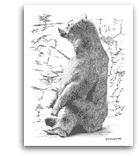 |
 |
|
|
GIANT
PANDAS (pair)
#PND-501
Notecards
#LE-PND-501 Limited Edition Print
Although
giant pandas are among the most recognizable animals in the world,
they rank among the rarest. Only about 1,000 giant pandas remain
in the mountain forests of central China, and about 140 live in
zoos and breeding centers.
Newborn
cubs weigh three to five ounces. They do not open their eyes until
they are six to eight weeks old and remain immobile until after
twelve weeks. After subsisting on their mother’s milk for the
first year, giant pandas begin thriving on a diet consisting almost
exclusively of bamboo. They grow to weights of up to 250 pounds.
Text
© 2001 Terry White, Drawing © 2001 Bill Harrah.
|
Back to Top |
|
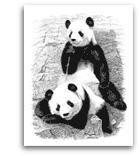
Giant
Panda
#LE-PND-501
Limited Edition Print
Issue Date: 11/2001
Edition Size: 500
Image: 6.5” x 8.25”
Paper: 8.5” x 11”
Mat: 11” x 14”
$35.
View
matted print
|
 |
|
Panda
Cub Tai Shan with Mother Mei Xiang
#PND-502
Notecards Only
#LE-PND-502 Limited Edition Print
Giant
pandas rank among both the rarest and most-recognized animals
in the world. Only about 1,600 of them survive in the temperate-zone
bamboo forests of central China. Another 140 live in breeding
facilities and zoos, including about 20 in zoos outside China.
So the birth of a cub to giant pandas Mei Xiang and Tian Tian
at the Smithsonian’s National Zoo in Washington, DC on July 9,
2005 created considerable excitement.
Indeed,
202,000 people voted in the naming contest. In accordance with
Chinese tradition, the cub received his name upon turning 100
days old. Although that name, Tai Shan, means “peaceful mountain,”
the blind, pink and nearly hairless baby was about the size of
a stick of butter at birth. Eventually, he will earn his name
by growing to as much as 250 pounds.
Although
his mother Mei Xiang seemed mystified by her cub at first, her
maternal instincts kicked in within minutes and the two became
inseparable for the next month. Like pandas in the wild, father
Tian Tian was not involved in the care of the cub.
Text
© 2006 Terry White, Drawing © 2006 Bill Harrah.
| Back to Top |
|
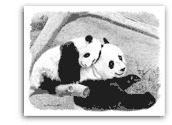
Tai
Shan & Mom
#LE-PND-502
Limited Edition Print
Issue Date: 07/2006
Edition Size: 500
Image: 6.5” x 8.25”
Paper: 8.5” x 11”
Mat: 11” x 14”
$35.
View
matted print
|
 |
|
GIANT
PANDA
#PND-500
Notecards Only
Also available in Notecard Assortment Pack #AST-511
Wild
giant pandas are found only in the Chinese provinces of Sichuan,
Shaanxi, and Gansu. They live in misty, cloud-covered forests,
high in the mountains.
Their
ears, shoulders, legs and tear-drop shaped patches around the
eyes are black. The rest of their fur is creamy white. The thick
coat consists of a coarse outer layer and a very dense, wooly-like
underfur. An oily protective coating on each hair helps keep the
panda dry in its cold, damp habitat.
Because
they have a plentiful food supply in all seasons, giant pandas
are one of four bear species that do not need to hibernate. They
feed primarily on the stems, twigs, leaves and fresh young shoots
of various types of bamboo. Giant pandas will also eat meat when
it is available. Since they are poor hunters, any animals they
eat have most likely been killed by another animal.
Giant
pandas are well-equipped for eating tough, fibrous bamboo. They
have powerful cheek muscles and broad heavily-ridged teeth. Their
flexible forepaws include an elongated wristbone that functions
like an opposable thumb, enabling them to grasp bamboo stalks
firmly. Tough linings in their esophagus and stomach protect pandas
from bamboo splinter injuries. Their intestinal systems, however,
are quite inefficient - requiring them to eat tremendous amounts
of bamboo each day to get sufficient nutrition.
The
mating season is the only time of year when the normally solitary
pandas come together. Each female panda has her own home range.
Within this range she has a favorite core area that will provide
enough food for herself and her cubs. Home ranges of males may
overlap ranges of several females.
Pregnant
females give birth in a den, usually a hollow tree or a cave.
Cubs are born at the end of the summer, when bamboo is most abundant.
The first month of a cub’s life is spent almost entirely
in the arms of its mother, who is extremely attentive. Cubs open
their eyes after about 6 weeks. By 5 months they can move about
without stumbling and falling. For about 1-1/2 years mom teaches
her cub everything it needs to know to be sufficiently self-reliant.
After leaving its mother, a cub will establish its own territory.
With
just over 1,000 left in the wild, giant pandas are on the verge
of extinction. They have become the international symbol of all
endangered species.
Please
Note: The animal above is described in less detail on the back
of the notecards, which were printed in 1993. The new description
will be used when cards are reprinted.
Text
© 1999 Dianne Harrah, Drawing © 1993 Bill Harrah.
| Back to Top |
|
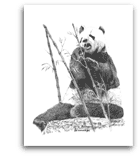 |
 |
|
|
POLAR
BEAR
#POB-500
Notecards Only
Weighing
in at as much as 1,500 pounds and measuring as long as 11 feet,
the polar bear is the biggest meat-eating hunter treading the
earth today. Only about 25,000 of these ivory-white bears descendants
of brown bears remain in the world, mostly along the northern
coasts of Russia, Alaska, Canada and Greenland.
A
layer of fat thicker than three inches combines with dense, oily
fur to protect them from the Arctic chill on both land and sea.
Polar bears even have fur on their dinner-plate-size paw bottoms
to prevent heat loss. These fur-covered soles additionally help
them avoid slipping on ice and muffle their approach as they sneak
up on their prey.
Surprisingly
fast and agile, polar bears can run up to 35 miles per hour and
swim 100 yards in 33 seconds. They also benefit from a sense of
smell so keen that they can detect food as far as ten miles away.
Polar bears prefer dining on seals, but their diet also includes
sea birds, lemmings, fish, berries, and grasses.
When
the weather grows too cold even for polar bears, they live in
dens that they typically dig in deep hillside snow banks. Pregnant
mother bears give birth in late November or early December. Usually
twins, newborn polar bears measure only about 10 inches long and
weigh about 1.5 pounds. Two years later, they strike out on their
own, often roaming the North for another 30 years or more.
Text
© 1998 Terry White, Drawing © 1998 Bill Harrah.
|
Back to Top |
|
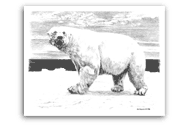 |
 |
|
SLOTH
BEARS
#SBR-500
Notecards Only
Also available in Notecard Assortment Pack #AST-511
Most
sloth bears are found in the forested areas and grasslands of
India and Sri Lanka. They have also been witnessed in Bangladesh,
Nepal, and Bhutan. Originally thought to be a member of the sloth
family in the late 18th century, the species’ true affiliation
with bears was not recognized until the early 19th century. Its
scientific name was changed to Melursus ursinus and the common
name was changed from “bear sloth” to “sloth bear.”
More recently the scientific name was changed again, this time
to Ursus ursinus.
Sloth
bears have a shaggy black coat that may have brown and grey hairs
mixed in. Cinnamon and reddish bears have also been reported.
Behind their heads, sloth bears have a thick mane-like ruff of
fur that covers their neck and part of their shoulders. On their
chest is a distinctive white or cream-colored chest patch in the
shape of a wide U, or sometimes a Y or V. Rounded ears are covered
with shaggy fur, giving them a floppy appearance. The long muzzle
is covered with very short white or cream-colored fur.
Particularly
well adapted to eating ants and termites, sloth bears use their
large curved claws to dig into termite mounds or tear logs apart
in search of ants and other insects. They have a long thin tongue,
nostrils that can be closed voluntarily, a hard palate, and large
protruding lower lips. They also lack front incisors. These mouth
adaptations enable them to form their long tongue and lips into
a tube so they can suck up termites and ants from exposed nests.
Sloth bears also eat other insects, berries, eggs, honeycomb,
grass, grubs and almost any kind of meat. Because food is plentiful
all year, sloth bears are one of four bear species that do not
need to hibernate.
Like
other bear species, sloth bears live a solitary existence, except
when raising young or mating. Females build earthen dens and typically
give birth to only one or two cubs. After four or five weeks,
the mother might take her young on their first trip outside the
den. Young sloth bear cubs ride on the back of their mother, clinging
onto her thick shaggy fur. Cubs remain with their mother two to
three years before becoming independent.
Please
Note: The animal above is described in less detail on the back
of the notecards, which were printed in 1993. The new description
will be used when cards are reprinted.
Text
© 1999 Dianne Harrah, Drawing © 1993 Bill Harrah.
|
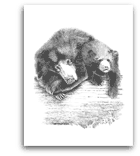 |
 |
|
| |
 |
|
|
 |
|
Copyright
Notice
Drawings Copyright © 1992-2013 Bill Harrah, Wolf Run Studio (SM), All Rights
Reserved. Wolf Run Studio is a service mark of Bill Harrah and has been in continuous
use since 1992. All of the images on this website are in tangible form and are
fully copyrighted. Each has an invisible digital identification which is traceable
through the Digimarc Corporation. Viewers of the Wolf Run Studio website are
allowed to browse and print out images for personal, non-commercial use only.
You may not distribute copies of images or image files to anyone else for any
reason. Images may not be reproduced or used in any form or any manner, or displayed
on any website without the express written consent of Bill
Harrah.
Text Copyright
© 1992-2013
Terry White or
Dianne Harrah. Text on this website is used with permission from the authors.
Viewers of the Wolf Run Studio website are allowed to browse and print out text
for personal, non-commercial use only. Text may not be reproduced or used in any
form or any manner without the express written consent of the authors.
Information
Accuracy
The information for the written description of each animal has been carefully
researched by the authors and is believed to be accurate. New scientific observations,
however, could make some information out-of-date. If you are a professional
zoologist, and have new information that you are willing to share, please contact
Dianne Harrah .
|
|
|
|



